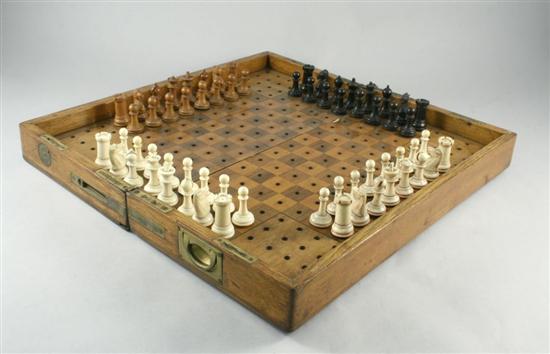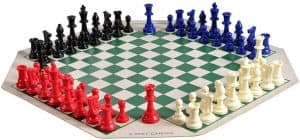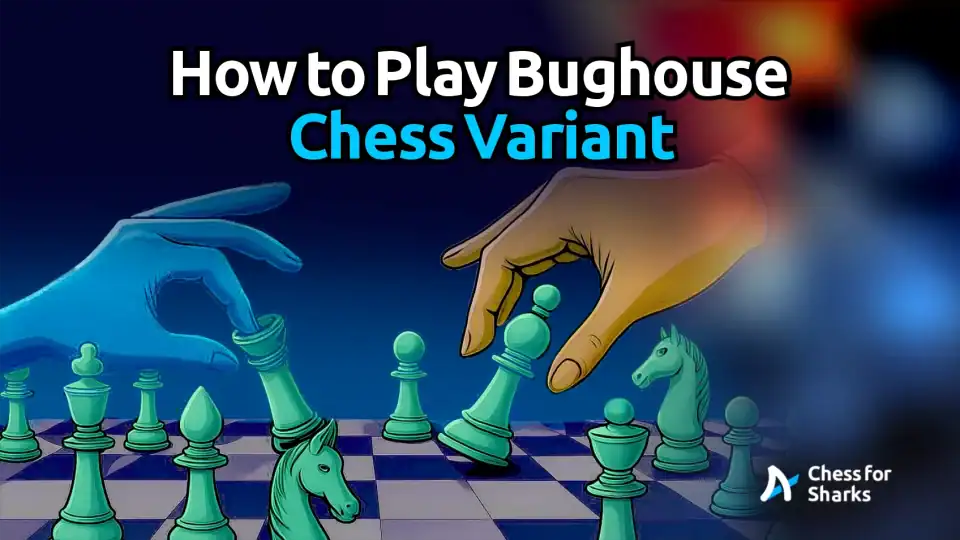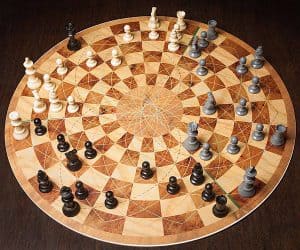
For over two hundred years, people have invented and reinvented several variants for four player chess, formed by adding a few (two, three, or four) rows to each side of an eight by eight board. In the opening setup, there are four sets of the 16 usual pieces, one on each of the four sides of the board, in four different colours.
Common four player chess rules
On each side, there’s a set of pieces in a different colour. The arrangement of the pieces is like that of the normal chess that you know except for the placement of the queens. This is an important thing to note, as attacks on kings may be easier when queens and kings start on the same line.
In the past, players form teams – each team consists of two players that sit opposite each other. Players take turns, either clockwise or anticlockwise. All pieces move like in orthodox chess. Friendly kings may be at adjacent squares. The object of the game is to mate both opponents; when a player is mated, then his pieces become immobile and he passes his turns. When the mate is released, he can resume play.
When his king is in check, a player must resolve it himself – he cannot wait for his partner to resolve the check on his own king.
Let’s have a look at some of the Four chess variants:
The game of Dessau
The first member of this family, described in The Encyclopedia of Chess Variants is dated 1784. The inventor is only known by initials K.E.G. and place Dessau. In this first variant, the board is formed by adding three rows to each side, thus obtaining a board with a total of 64+438 = 160 squares.

In this variant, all queens are on white squares in the opening setup. Pawns have no initial double step. When a player is released from mate, his pieces may not be taken until after his next move.
Altenburg
A few years later, in 1792, the first variant with a board with extensions of `width’ two is reported in the German town of Altenburg. In this variant, pawns on rook lines are not allowed to capture each other from their starting position.
Four Player Chess on Chess.com
Four Player Chess on Chess.com is a little bit different from the more traditional rules. In the past, it was usually 2-vs-2 or last man standing. Later studies revealed that the system rewards the most cautious player rather than the most ambitious. Hence, Chess.com chose a points-based approach, which would balance aggressive play and also reward going after the other kings.
BASIC STRATEGIES (as provided by Chess.com CCO, IM Danny Rensch)
The most dangerous player on the board is the one to your left. If this player checks you (or plays another powerful attacking or capturing move), there are now two more players who can pile up with other tempo moves before it’s your turn. So always look left!
Never assume a recapture. Just like in real chess, where we should try to be aware of “zwischenzugs” (in-between tactics), in Four Player Chess; weird, surprising moves come from everywhere. So when you think you’re calculating a “forced line,” think again!
Bishops = best. OK, Not really, but they are darn good. This is a hard psychological thing to get behind at first when considering “bishop trades for knights” because you’re used to this being OK in regular chess. It’s normally a TERRIBLE idea in Four Player. Bishops are worth five (appropriately) like the rooks, but in some positions, they may be the most important, most dangerous pieces on the board, launching from one side to another.
Pawn promotion is key. Some players employ early “pawn-rush” strategies to get that coveted second queen, while others like to slow play with multiple pawns, anticipating that it won’t be the first one to queen who matters, but who can get two or even three extra queens. It happens! So watch out!
Finally, despite all I said, don’t completely walk away from classical chess principles. As more Four Player chess theory has developed, you will often see the stronger players doing things like fianchettoing a bishop, getting castled, moving rooks to the centre behind advancing pawns and developing ALL of their pieces before going crazy with attacks.
Check out other interesting chess variants you probably don’t know exists.







join the conversation